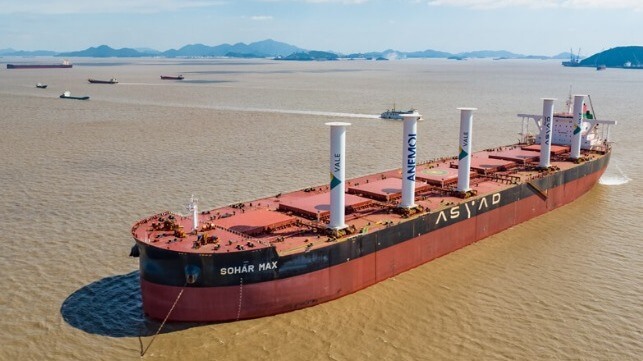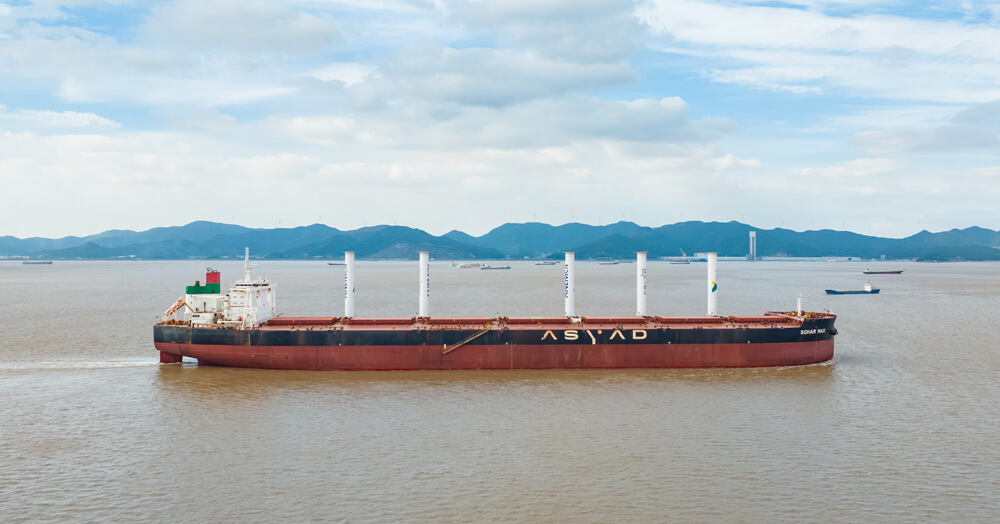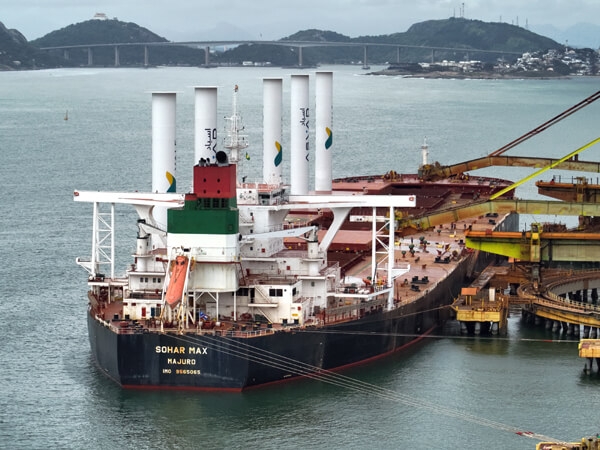Mainstream Adoption of Rotor Sails Within the Global Fleet

The installation of five Rotor Sails from Anemoi Marine Technologies onboard Sohar Max, a 400,000 dwt Very Large Ore Carrier, in late 2024 was a landmark moment for the wider wind-assisted propulsion systems (WAPS) sector for two reasons.
The first was that the project, which took place at the COSCO Zhoushan shipyard in China, marked the largest wind propulsion installation to date.
The first-generation Valemax, which was built in 2012 and owned by Omani shipowner Asyad and chartered by Brazilian mining giant Vale, was retrofitted with five 35-meter tall Rotor Sails on its port side deck to reduce fuel consumption significantly, equating to an expected carbon emission reduction of up to 3,000 tonnes annually. The Rotor Sails were installed on Anemoi’s bespoke folding deployment system, which enable the sails to be folded from vertical to mitigate any impacts on the vessel’s cargo handling operations.
Secondly, the project demonstrated the growing confidence of shipowners in wind power, particularly Rotor Sails, as a reliable means of auxiliary propulsion. This shift reflects their growing commitment to reducing carbon emissions and complying with essential environmental regulations as the shipping industry progresses on its decarbonization journey.
With Rotor Sails now installed on some of the world’s biggest and most important vessels, plying the most predominant trade routes, the scene is now set for wind-propulsion systems to become a much more common sight for shipowners and operators around the world as a means to curb emissions and improve efficiency of commercial vessels.

High-performing, compact, low maintenance, and quality
“Anemoi Rotor Sails are proven as a high-performing, compact, low maintenance and quality wind-propulsion technology for vessel owners looking to meet the more stringent environmental targets set by the International Maritime Organization, regional authorities, or local ports,” said Clare Urmston, Chief Executive Officer of Anemoi.
“The installation of Anemoi’s Rotor Sails onboard the Sohar Max was the clearest indication yet that wind propulsion has found its place in modern shipping operations.”
According to the United Kingdom’s Clean Maritime Plan, the wind-propulsion technology market is expected to reach £2 billion (US$2.5 billion) by 2050, a substantial rise from the projected £300 million (US$373 million) of the 2020s.
This level of growth is not just down to shipowners realizing the environmental benefits of Rotor Sails but also understanding how they are another tool in their toolbox to make their operations more efficient, particularly when combined with other efficiency tools and fuels, both now and in the future.
“Shipowners are under immense pressure to go green, but they also have operational factors and financial implications to consider when deciding how to get there. We’re often asked what Anemoi Rotor Sails offer that others don’t. We focus on the practical application of Rotor Sails, delivering solutions designed specifically for vessel operations. Our unique modular, plug-and-play system enables fast installation with the option to commission at sea, shortening the time out of service. With minimal vessel downtime, our flexible deployment systems also ensure cargo handling remains uninterrupted. Built for durability, our Rotor Sails feature a 25-year design lifespan with very low maintenance costs, offering shipowners a reliable, efficient, and long-term investment tailored to a wide range of vessel types,” Urmston added.
For this reason, Rotor Sails have become the technology of choice for the modern vessel. They are a visible and cost-effective decarbonization technology that can be quickly installed while the vessel is at berth, reducing downtime and providing immediate results for the vessel’s very next voyage.
“The benefits achieved from installations on some of the world’s biggest vessels carrying some of the world’s most vital cargoes is proof that every ship owner with a suitable vessel can achieve similar immediate success,” Urmston noted.
Commercial considerations that extend beyond the upfront investment
While installing wind-propulsion technology provides clear environmental and financial incentives for a vessel, as well as boosting its commercial attractiveness to the wider market, owners remain vigilant in their need to ensure that they do not impact the vessel’s cargo operations or prevent it from accessing key waterways.
“Commercial operations are king. If you’ve invested millions in a vessel, you want to see that return on investment. If onboard technologies limit the amount of cargo you can take onboard or impact the speed at which you are able to load or unload the cargo, then that hits the vessel’s bottom line,” said Luke McEwen, Technical Director of Anemoi.
“This is why Rotor Sails are the market leader in the wind-propulsion technology space, compared to say solid wings or suction wings. The sails are only 35 m tall and 5m wide, which, when compared to a vessel that is more than 350 m long, makes them a compact solution that provides a significant amount of fuel and emissions savings due to a high thrust per square meter, while ensuring that cargo operations are not significantly affected.
“Rotor Sails being a compact piece of equipment also gives it a huge number of aerodynamic advantages. With a Rotor Sail, if you put a small amount of power in, you can pretty much get 10 times the power back through renewable wind energy, ensuring a vessel can make the efficiency gains it is looking for along with a long-term positive environmental impact,” he added.
“The lifetime maintenance costs of a wind-propulsion solution should be taken into consideration when assessing each technology. At Anemoi, we have combined intelligent design with unique and patented manufacturing processes and the highest quality marine components to produce a solution made to keep costs low throughout its lifespan, from fast installation cost savings to lower maintenance costs. Anemoi’s approach is not just about getting sails on ships but making sure they are effective throughout the full 25-year design lifespan,” said Urmston.

Gamechanger
With Sohar Max at sea and operating on deep-sea routes between Brazil, China, and the Middle East, the vessel stands as a landmark in the journey of Rotor Sails from niche product to mainstream appeal.
With production capacity ramping up at its China facilities, Anemoi stands ready to help the global fleet on its decarbonization journey. With an award-winning formula combining cleverly designed Rotor Sails and operational solutions suitable for most vessels, Anemoi’s Rotor Sails are the next evolution of WAPS technology and the next stage of wind power’s game-changing capabilities in modern shipping.
This article is sponsored by Anemoi Marine Technologies. Find out how much your vessel can save in fuel and emissions with Anemoi's Rotor Sails today at https://anemoimarine.com/flettner-rotor-efficiency/#example-saving-assessments.
The opinions expressed herein are the author's and not necessarily those of The Maritime Executive.
